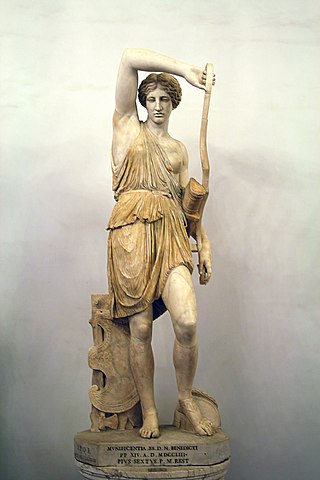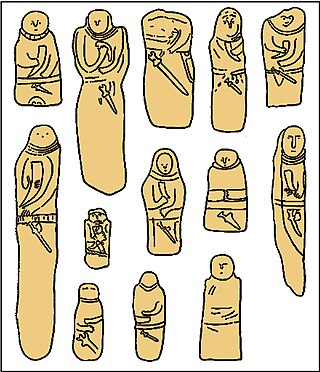Related Research Articles

The Amazons were a people in Greek mythology, portrayed in a number of ancient epic poems and legends, such as the Labours of Heracles, the Argonautica and the Iliad. They were female warriors and hunters, known for their physical agility, strength, archery, riding skills, and the arts of combat. Their society was closed to men and they raised only their daughters and returned their sons to their fathers, with whom they would only socialize briefly in order to reproduce.

The Scythians or Scyths in composition) and sometimes also referred to as the Pontic Scythians, were an ancient Eastern Iranic equestrian nomadic people who had migrated during the 9th to 8th centuries BC from Central Asia to the Pontic Steppe in modern-day Ukraine and Southern Russia, where they remained established from the 7th century BC until the 3rd century BC.

The Sarmatians were a large confederation of ancient Iranian equestrian nomadic peoples who dominated the Pontic steppe from about the 3rd century BC to the 4th century AD.
The Massagetae or Massageteans, also known as Sakā tigraxaudā or Orthocorybantians, were an ancient Eastern Iranian Saka people who inhabited the steppes of Central Asia and were part of the wider Scythian cultures. The Massagetae rose to power in the 8th to 7th centuries BCE, when they started a series of events with wide-reaching consequences by expelling the Scythians out of Central Asia and into the Caucasian and Pontic Steppes. The Massagetae are most famous for their queen Tomyris's alleged defeating and killing of Cyrus, the founder of the Persian Achaemenid Empire.

Tomyris also called Thomyris, Tomris, or Tomiride, was a queen of the Massagetae who ruled in the 6th century BCE. Tomyris is known only from the writings of the Greek historian Herodotus of Halicarnassus, according to whom Tomyris led her armies to defend against an attack by Cyrus the Great of the Achaemenid Empire, and defeated and killed him in 530 BC.
The Spartocids or Spartocidae was the name of a Hellenized Thracian dynasty that ruled the Hellenistic Kingdom of Bosporus between the years 438–108 BC. They had usurped the former dynasty, the Archaeanactids, who were tyrants of Panticapaeum from 480 to 438 BC. The throne of the Bosporan Kingdom was usurped by Spartokos I in 438 BC, after whom the dynasty is named.
Madyes was a Scythian king who ruled during the period of the Scythian presence in West Asia in the 7th century BCE.
Queen Anula of Anuradhapura was the first queen regnant in Sri Lankan history, as well as the first documented female head of state in Asia. Anula initially rose to power as a consort of King Chore Naga, son of King Valagambahu of Anuradhapura. However, in her five-year reign, she poisoned her way through at least four other husbands and consorts, causing her to govern Rajarata on her own eventually. Queen Anula of Anuradhapura differs from another famous figure in Sri Lankan history, also named Anula. She is a different figure as she is King Devanampiyatissa's sister-in-law, the first woman in Sri Lanka to be ordained as a bikkhuni. The primary source for Anula's reign is the Mahavamsa, chapters 34 and 35.
Tirgatao was a princess of the Maeotes mentioned by Polyaenus. She was the first wife of the Sindian king Hecataeus, and was a notable participant of the Bosporan wars of expansion.

The role of women in ancient warfare differed from culture to culture. There have been various historical accounts of females participating in battle.

The Scythian religion refers to the mythology, ritual practices and beliefs of the Scythian cultures, a collection of closely related ancient Iranian peoples who inhabited Central Asia and the Pontic–Caspian steppe in Eastern Europe throughout Classical Antiquity, spoke the Scythian language, and which included the Scythians proper, the Cimmerians, the Sarmatians, the Alans, the Sindi, the Massagetae and the Saka.

Lampedo is an Amazon queen mentioned in Roman historiography. She ruled with her sister Marpesia. The sisters called themselves daughters of Mars to put terror in the heart of their enemies to show they were incredible warriors to be feared. Her name was speculated to refer to traditional New Moon torchlit processions in honor of Artemis, goddess of the hunt.

Asander, named Philocaesar Philoromaios was a Roman client king of the Bosporan Kingdom. He was of Greek and possibly of Persian ancestry. Not much is known of his family and early life. He started his career as a general under Pharnaces II, the king of the Bosporus. According to some scholars, Asander took as his first wife a woman called Glykareia, known from one surviving Greek inscription, "Glykareia, wife of Asander".

Virata Parva, also known as the “Book of Virata”, is the fourth of eighteen books of the Indian epic Mahabharata. Virata Parva traditionally has 4 parts and 72 chapters. The critical edition of Virata Parva has 4 parts and 67 chapters.

Dynamis, nicknamed Philoromaios, was a Roman client queen of the Bosporan Kingdom during the Late Roman Republic and part of the reign of Augustus, the first Roman Emperor. Dynamis is an ancient Greek name which means the “powerful one”. She was a monarch of Iranian and Greek Macedonian ancestry. She was the daughter of King Pharnaces II of Pontus and his Sarmatian wife. She had an older brother called Darius and a younger brother called Arsaces. Her paternal grandparents had been the monarchs of the Kingdom of Pontus, Mithridates VI of Pontus and his first wife Laodice, who was also his sister. Dynamis married three times. Her husbands were Asander, a certain Scribonius and Polemon I of Pontus. According to Rostovtzeff, she also had a fourth husband, Aspurgos.
Leucon I of Bosporus also known as Leuco, was a Spartocid ruler of the Bosporan Kingdom who ruled from 389 to 349 BC. He was arguably the greatest ruler of the Bosporan Kingdom.
Camasarye II Philoctenus or Comosarye was a daughter of Spartocus V and a Spartocid queen of the Bosporan Kingdom from 180-160/150 BC. She was the wife of her cousin Paerisades III and a granddaughter of Leucon II. She co-ruled with Paerisades III.

Sakez also known as Sekez, Sekakez and Scyth (Eskit) was a sizable urban settlement and historical ancient city in the first millennium BC in Iran. It was the political and military capital of Scythians in western Iran and one of the few ancient cities that has been the residence of people and the center of civilization and it still is. Archaeologists believe that the present-day city of Saqqez in Kurdistan is the remnant of the city of Sakez, which takes its name from the Scythians and, with a slight change in pronunciation, is still called by the same name.

The Scythian kingdom in Crimea was a kingdom created by the Scythians during the 3rd century BCE in Crimea.
References
- 1 2 Polyaenus, Strategems, 8.56
- ↑ Jessica Amanda Salmonson (7 April 2015). The Encyclopedia of Amazons: Women Warriors from Antiquity to the Modern Era. ISBN 978-1453293645.
- ↑ Polyaenus: Stratagems - Book 8, Chapters 26-71, chapter 56. Translation by Andrew Smith, Adapted from the translation by R.Shepherd (1793). http://www.attalus.org/translate/polyaenus8B.html, accessed July 9, 2014
- ↑ The Role of Women in the Altaic World, edited by Veronika Veit, 2007, p.261